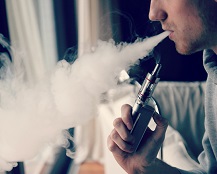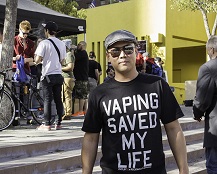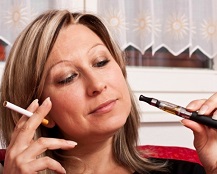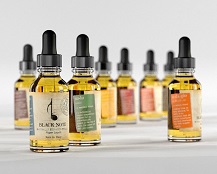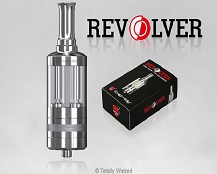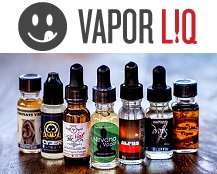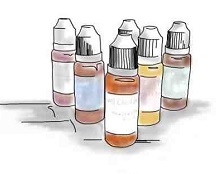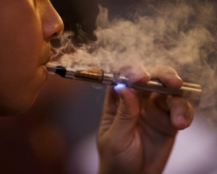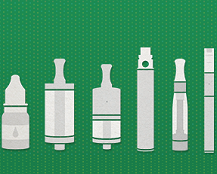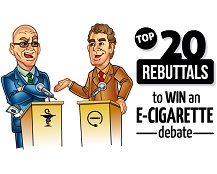An underlying distrust of anything resembling smoking leads some of those in tobacco control to claim that we don’t even need e-cigarettes, and to look for any reason to cast doubt on the value of vaping. But the reason we really do need vaping becomes obvious as soon as you consider things from the perspective of a smoker.
The worst thing about the continuous spread of misleading information and the manufacturing of misguided panics about vaping is the fact that e-cigarettes are really about harm reduction. Arguments like “e-cigarettes aren’t absolutely safe” are ridiculous in the context of harm reduction, and this becomes pretty clear when you apply common anti-vaping arguments to other forms of harm reduction.
For smokers just switching to vaping, one of the most common questions is: “which e-liquid will taste like my favorite brand of cigarettes?” However, you quickly learn that finding an e-liquid that tastes like Marlboro cigarettes, for example, is not an easy task. So, do you keep searching for the e-liquid that will manage to perfectly replicate your chosen brand of cigarettes, or is there another way?
Naturally-extracted tobacco (NET) e-liquid is widely-recommended by those searching for the most realistic tobacco e-liquids, but results from e-liquid chemical and toxicological studies would suggest that they carry slightly greater risks than your average e-liquid. But is the added risk worthwhile? We take a look at the pros and cons of NET e-liquids.
The California Department of Public Health’s Still Blowing Smoke campaign and the CDC’s tips campaign are just two of the latest examples of why tobacco harm reduction is so widely misunderstood by the public. But why is the anti-science, chemo-phobic propaganda winning the PR war over e-cigarettes?
Need to write an innuendo-laden, scientific-sounding piece of scaremongering bullshit good enough to make an ex-smoking vaper decide to toss away the safer alternative and pick up a pack of comfortingly-deadly traditional cigarettes? Never fear: we have you covered.
Since most vapers change e-liquids at least once during the course of a day’s vaping, Totally Wicked has provided a tank atomizer perfectly suited to our needs, allowing you to fill up with two different e-liquids and change between (or combine) them by simply twisting a selection dial.
If you haven't tried an e-liquid subscription in the past and are looking for some new flavors, or if you've tried one but want something more refined, Vapor Liq might just be the answer.
E-cig devices like Joyetech eVic and Smokio offer plenty of stats on your vaping habits, but how useful can these stats be to the average vaper?
Companies like Vapor Chef, Namber Juice, and Five Pawns offer ranges of “gourmet” e-liquid, complete with complex, carefully balanced and exotic flavors and borderline pornographic descriptions. But is it all hot air?
A review of top e-liquid subscription companies, including ZampleBox, VapeBox, The Drip Club, Easy Vape Club, Craft Vapery, and Zodist.
Could you vape your way to a fatal nicotine overdose? Bernd Mayer investigated the source of the claim and we now have his answer.
The anti-vaping movement, or more broadly the anti-smoking movement, is driven by ideology, and ideology is downright awful at science.
Group buys essentially bypass the vendor, or middle man, allowing the consumer to purchase directly from the manufacturer. Massdrop and Congrevape are seeking to standardize vaping group buys to what can be expected with more traditional products.
The Merry E-Cigarette Vaping Christmas Game, by Brian Fojtik.
Thoughts on electronic cigarette regulation from vapers, advocates, researchers and bloggers. The vaping community speaks! How should the FDA regulate e-cigs?
This past Wednesday the most populous city in the United States held a public hearing to discuss a proposed amendment to the New York Clean Indoor Air Act. The bill, sponsored by NYC Councilman James F. Gennaro, seeks to regulate usage of electronic cigarettes the same way smoking is prohibited in public places like restaurants, bars, workplaces and parks.
Spare a thought for the anti-vaping zealots, those who are opposed to e-cigarettes or tobacco in any form, who continually have to rely on similarly flawed arguments in order to make it look like they're maintaining a defensible position. Reading through anti-e-cig arguments is like taking a whistle-stop tour of logical fallacies, and here is our top 10 of the most common.
20 of the most commonly heard anti e-cig arguments rebutted by scientists, researchers, and advocates including Dr. Michael Siegel, Dr. Carl V. Phillips, Dr. Farsalinos, Dr. Ross, Chris Price, James Dunworth, Gregory Conley, Paul Bergen, Kristin Noll-Marsh, and Oliver Kershaw.
Do you think e-cigs pose a risk to bystanders? Studies have shown that the vapor of e-cigarettes is less harmful than the air you inhale on a regular basis.

